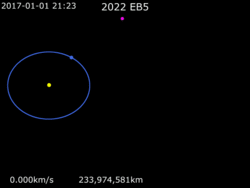Astronomy:2022 EB5
| Discovery[1][2] | |
|---|---|
| Discovered by | Krisztián Sárneczky |
| Discovery site | Piszkéstető Stn. |
| Discovery date | 11 March 2022 |
| Designations | |
| 2022 EB5 | |
| Sar2593[3] | |
| Minor planet category | NEO[lower-alpha 1] · Apollo[6][1] |
| Orbital characteristics[6] | |
| Epoch 11 March 2022 (JD 2459649.5) | |
| Uncertainty parameter 6 | |
| Observation arc | 1.9 hours[1] |
| |{{{apsis}}}|helion}} | 4.772 AU |
| |{{{apsis}}}|helion}} | 0.888 AU |
| 2.830 AU | |
| Eccentricity | 0.6863 |
| Orbital period | 4.76 yr (1,738 days) |
| Mean anomaly | 353.614° |
| Mean motion | 0° 12m 25.472s / day |
| Inclination | 10.422° |
| Longitude of ascending node | 350.992° |
| |{{{apsis}}}|helion}} | July 2017 (last perihelion) |
| 222.416° | |
| Earth MOID | 3717 km |
| Jupiter MOID | 0.661 AU |
| Physical characteristics | |
| Mean diameter | 2 m[4] |
| Absolute magnitude (H) | 31.33±0.35[6] |
2022 EB5 was a small, two-metre Apollo near-Earth asteroid that disintegrated in Earth's atmosphere at 21:22 UTC on 11 March 2022, over the Arctic Ocean southwest of the Norway island Jan Mayen. With an atmospheric entry speed of 18 km/s (11 mi/s), the asteroid's impact generated a 4-kiloton-equivalent fireball that was detected by infrasound from Greenland and Norway.[7][8] A bright flash possibly associated with the event was reported by observers from Northern Iceland.[8]
It was discovered by astronomer Krisztián Sárneczky at Konkoly Observatory's Piszkéstető Station in Mátra Mountains, Hungary about two hours before impact.[2][8] 2022 EB5 is the fifth asteroid discovered before impacting Earth.[8][4] It was briefly listed on the Minor Planet Center's Near-Earth Object Confirmation Page under the temporary designation Sar2593.[3]
See also
Notes
- ↑ 2022 EB5 is not considered a potentially hazardous object (PHO) due to its small size.[4] A PHO is defined by having an Earth minimum orbit intersection distance (MOID) of 0.05 AU or less, and having an absolute magnitude of 22 or brighter.[5]
References
- ↑ 1.0 1.1 1.2 "2022 EB5". Minor Planet Center. https://www.minorplanetcenter.net/db_search/show_object?object_id=2022+EB5. Retrieved 11 March 2022.
- ↑ 2.0 2.1 "MPEC 2022-E178 : 2022 EB5". Minor Planet Center. 11 March 2022. https://minorplanetcenter.net/mpec/K22/K22EH8.html. Retrieved 11 March 2022.
- ↑ 3.0 3.1 ""Pseudo-MPEC" for Sar2593". Project Pluto. 11 March 2022. https://www.projectpluto.com/neocp2/mpecs/Sar2593.htm. Retrieved 11 March 2022.
- ↑ 4.0 4.1 4.2 "NASA System Predicts Impact of Small Asteroid". NASA. 15 March 2022. https://www.nasa.gov/feature/jpl/nasa-system-predicts-impact-of-small-asteroid. Retrieved 16 March 2022.
- ↑ "NEO Basics". Jet Propulsion Laboratory. https://cneos.jpl.nasa.gov/about/neo_groups.html. Retrieved 13 March 2022.
- ↑ 6.0 6.1 6.2 "JPL Small-Body Database Browser: (2022 EB5)". Jet Propulsion Laboratory. https://ssd.jpl.nasa.gov/tools/sbdb_lookup.html#/?sstr=54254967. Retrieved 11 March 2022.
- ↑ "Firesballs Reported by US Government Sensors". NASA Jet Propulsion Laboratory. https://cneos.jpl.nasa.gov/fireballs/.
- ↑ 8.0 8.1 8.2 8.3 Antier, Karl (13 March 2022). "2022 EB5 : 5th predicted Earth impact!". International Meteor Organization. https://www.imo.net/2022-eb5-5th-predicted-earth-impactor-asteroid-on-march-11/. Retrieved 15 March 2022.
External links
- 2022 EB_5, Daniel W. E. Green, Central Bureau Electronic Telegram, Central Bureau for Astronomical Telegrams, 13 March 2022
- 2022 EB5 at NeoDyS-2, Near Earth Objects—Dynamic Site
- Ephemeris · Obs prediction · Orbital info · MOID · Proper elements · Obs info · Close · Physical info · NEOCC
- 2022 EB5 at ESA–space situational awareness
- 2022 EB5 at the JPL Small-Body Database
 |



